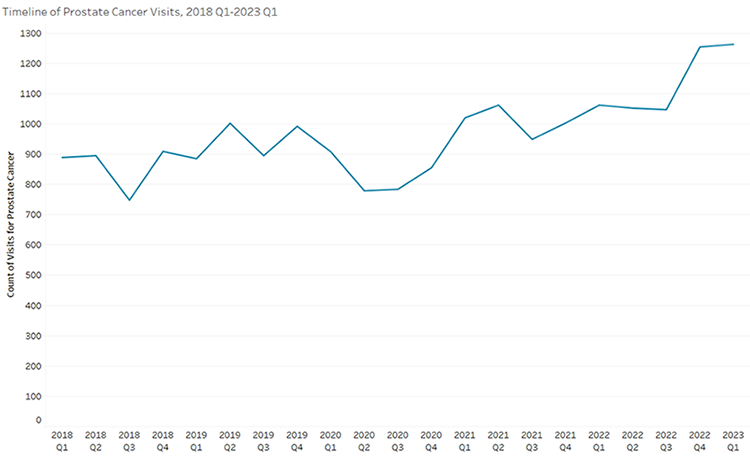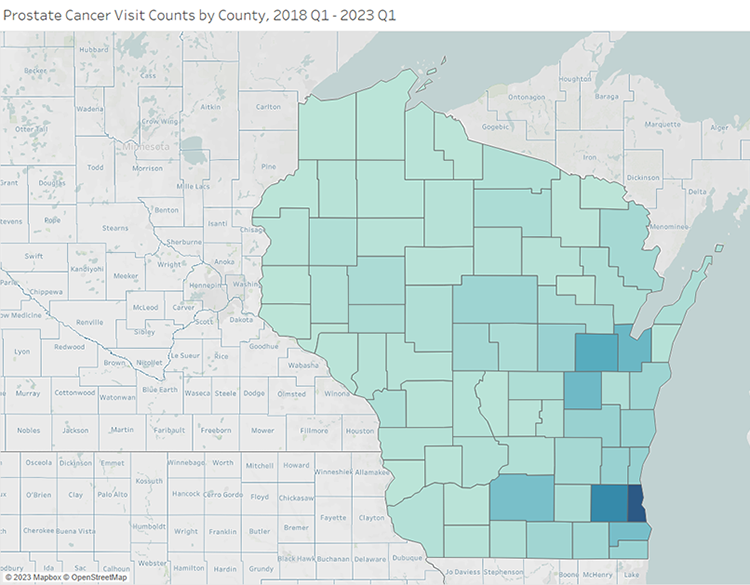Vol. 67, Issue 38
View more issues of The Valued Voice
Sign Up for WHA's Newsletter
Click here to view past issues
IN THIS ISSUE
- WHA Expresses Concerns with WI Congressional Delegation Over Site-Neutral Proposals in House and Senate
- WHA Workforce Forum Focuses on Partnering to Grow Faster
- Unique Leadership Training Experience - Launching of the 2024 Health Care Leadership Academy
- GUEST COLUMN: 2023 Commercial Property Insurance Market Report: Mid-Year Update
- Fast Facts from the WHA Information Center: September is Prostate Cancer Awareness Month
EDUCATION EVENTS
Dec. 16, 2025
Common Hospital DeficienciesJan. 14, 2026
Caring for Wisconsin’s Caregivers Well-Being First Champion Challenge for Credentialing KickoffJan. 28, 2026
2026 WHA Health Care Leadership AcademyClick here to view education event calendar
View more issues of The Valued Voice
Sign Up for WHA's Newsletter
Thursday, September 21, 2023
 September is known as Prostate Cancer Awareness Month to educate and bring attention to the most
September is known as Prostate Cancer Awareness Month to educate and bring attention to the most common non-skin cancer in the United States. Prostate cancer is the second leading cause of death in men after lung cancer. The prostate gland is found below the bladder and only in men. The Center for Disease Control and Prevention states that 13 out of 100 American men will be diagnosed with prostate cancer in their lifetime. The new estimate of cases of prostate cancer to be diagnosed in 2023 is just under 300,000.
common non-skin cancer in the United States. Prostate cancer is the second leading cause of death in men after lung cancer. The prostate gland is found below the bladder and only in men. The Center for Disease Control and Prevention states that 13 out of 100 American men will be diagnosed with prostate cancer in their lifetime. The new estimate of cases of prostate cancer to be diagnosed in 2023 is just under 300,000.
According to the American Cancer Society, 1 in 41 men will die of prostate cancer, but the death rate has decreased by almost half from 1993 to 2013. This is most likely due to increased screenings and treatment advances. In more recent years, however, there has been a slight uptick in case numbers. The most common risk factor for being diagnosed is age—the older a man is, the greater chance of prostate cancer.

The WHA Information Center analyzed prostate cancer-related visits from the past five years. The average age of patients visiting for prostate-related cancer is 67 years old. The American Cancer Society states that the chance of being diagnosed increases dramatically after age 50 and almost 6 in 10 cases are found in men 65 years and older. Since 2018, there has been a slow rise in visits related to prostate cancer, which follows the national trend. African Americans have a high rate of visiting for prostate cancer. Outpatient facilities saw by far the highest number of visit counts, followed by inpatient.

Here are some of the most common risk factors for men to develop prostate cancer from the American Cancer Society:
Fast Facts from the WHA Information Center: September is Prostate Cancer Awareness Month
 September is known as Prostate Cancer Awareness Month to educate and bring attention to the most
September is known as Prostate Cancer Awareness Month to educate and bring attention to the most common non-skin cancer in the United States. Prostate cancer is the second leading cause of death in men after lung cancer. The prostate gland is found below the bladder and only in men. The Center for Disease Control and Prevention states that 13 out of 100 American men will be diagnosed with prostate cancer in their lifetime. The new estimate of cases of prostate cancer to be diagnosed in 2023 is just under 300,000.
common non-skin cancer in the United States. Prostate cancer is the second leading cause of death in men after lung cancer. The prostate gland is found below the bladder and only in men. The Center for Disease Control and Prevention states that 13 out of 100 American men will be diagnosed with prostate cancer in their lifetime. The new estimate of cases of prostate cancer to be diagnosed in 2023 is just under 300,000.According to the American Cancer Society, 1 in 41 men will die of prostate cancer, but the death rate has decreased by almost half from 1993 to 2013. This is most likely due to increased screenings and treatment advances. In more recent years, however, there has been a slight uptick in case numbers. The most common risk factor for being diagnosed is age—the older a man is, the greater chance of prostate cancer.

The WHA Information Center analyzed prostate cancer-related visits from the past five years. The average age of patients visiting for prostate-related cancer is 67 years old. The American Cancer Society states that the chance of being diagnosed increases dramatically after age 50 and almost 6 in 10 cases are found in men 65 years and older. Since 2018, there has been a slow rise in visits related to prostate cancer, which follows the national trend. African Americans have a high rate of visiting for prostate cancer. Outpatient facilities saw by far the highest number of visit counts, followed by inpatient.

Here are some of the most common risk factors for men to develop prostate cancer from the American Cancer Society:
- Age: The chance of being diagnosed with prostate cancer rises rapidly after age 50.
- Race/Ethnicity: African American men and Caribbean men of African ancestry are more likely to develop prostate cancer than men of other races. And when it does develop in these men, they tend to be younger. Prostate cancer occurs less often in Asian American, Hispanic and Latino men.
- Geography: Prostate cancer is more commonly found in North America, Australia, northwestern Europe and some Caribbean islands. It is less common in Asian, Africa and Central and South America.
- Family History: The risk for developing is higher for men who have relatives diagnosed with prostate cancer. Having a father or brother with prostate cancer more than doubles a man’s risk of developing this disease.
Vol. 67, Issue 38
Thursday, September 21, 2023
Fast Facts from the WHA Information Center: September is Prostate Cancer Awareness Month
 September is known as Prostate Cancer Awareness Month to educate and bring attention to the most
September is known as Prostate Cancer Awareness Month to educate and bring attention to the most common non-skin cancer in the United States. Prostate cancer is the second leading cause of death in men after lung cancer. The prostate gland is found below the bladder and only in men. The Center for Disease Control and Prevention states that 13 out of 100 American men will be diagnosed with prostate cancer in their lifetime. The new estimate of cases of prostate cancer to be diagnosed in 2023 is just under 300,000.
common non-skin cancer in the United States. Prostate cancer is the second leading cause of death in men after lung cancer. The prostate gland is found below the bladder and only in men. The Center for Disease Control and Prevention states that 13 out of 100 American men will be diagnosed with prostate cancer in their lifetime. The new estimate of cases of prostate cancer to be diagnosed in 2023 is just under 300,000.According to the American Cancer Society, 1 in 41 men will die of prostate cancer, but the death rate has decreased by almost half from 1993 to 2013. This is most likely due to increased screenings and treatment advances. In more recent years, however, there has been a slight uptick in case numbers. The most common risk factor for being diagnosed is age—the older a man is, the greater chance of prostate cancer.

The WHA Information Center analyzed prostate cancer-related visits from the past five years. The average age of patients visiting for prostate-related cancer is 67 years old. The American Cancer Society states that the chance of being diagnosed increases dramatically after age 50 and almost 6 in 10 cases are found in men 65 years and older. Since 2018, there has been a slow rise in visits related to prostate cancer, which follows the national trend. African Americans have a high rate of visiting for prostate cancer. Outpatient facilities saw by far the highest number of visit counts, followed by inpatient.

Here are some of the most common risk factors for men to develop prostate cancer from the American Cancer Society:
- Age: The chance of being diagnosed with prostate cancer rises rapidly after age 50.
- Race/Ethnicity: African American men and Caribbean men of African ancestry are more likely to develop prostate cancer than men of other races. And when it does develop in these men, they tend to be younger. Prostate cancer occurs less often in Asian American, Hispanic and Latino men.
- Geography: Prostate cancer is more commonly found in North America, Australia, northwestern Europe and some Caribbean islands. It is less common in Asian, Africa and Central and South America.
- Family History: The risk for developing is higher for men who have relatives diagnosed with prostate cancer. Having a father or brother with prostate cancer more than doubles a man’s risk of developing this disease.
IN THIS ISSUE
- WHA Expresses Concerns with WI Congressional Delegation Over Site-Neutral Proposals in House and Senate
- WHA Workforce Forum Focuses on Partnering to Grow Faster
- Unique Leadership Training Experience - Launching of the 2024 Health Care Leadership Academy
- GUEST COLUMN: 2023 Commercial Property Insurance Market Report: Mid-Year Update
- Fast Facts from the WHA Information Center: September is Prostate Cancer Awareness Month

